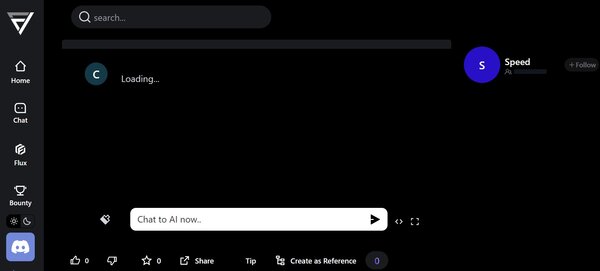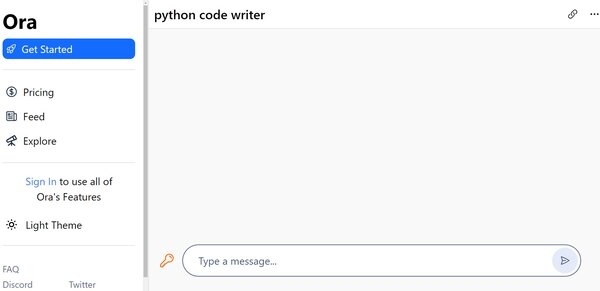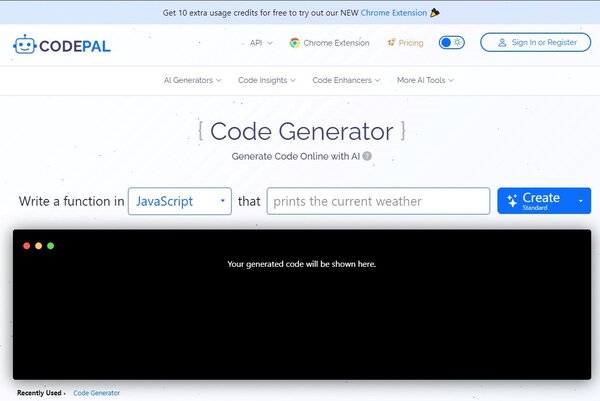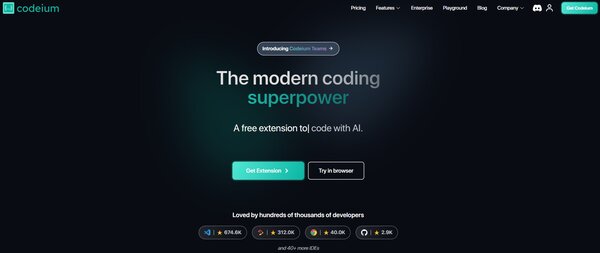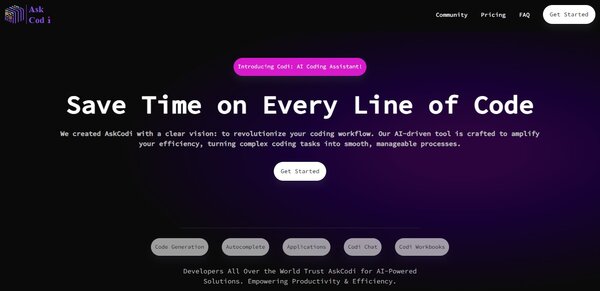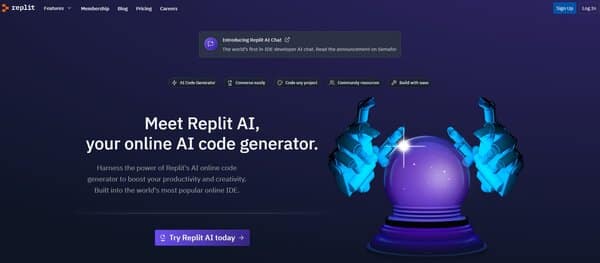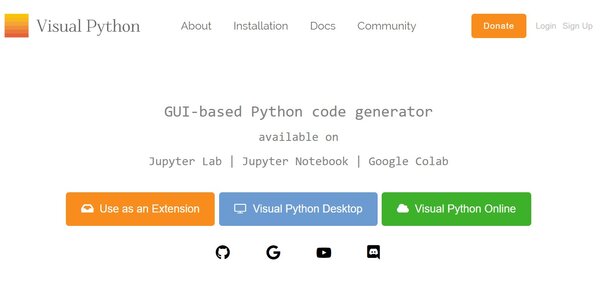10 Best Python Code Generators
Python has become a cornerstone in the world of programming, thanks to its simplicity and versatility. It’s a language that both beginners and seasoned developers turn to for a wide range of projects, from web development to data science. But as projects grow in complexity, the need for efficient coding practices becomes paramount. This is where Python code generators come into play, offering a solution to streamline the development process.
The Need for Python Code Generator
In the landscape of software development, efficiency and speed are of the essence. Python code generators address this need by automating the creation of boilerplate code, which can be both time-consuming and prone to errors if done manually. These tools are not just about speeding up the development process, they also ensure consistency across the codebase, making it easier to maintain and update projects.
One of the primary advantages of using an AI code generator and Python code generator is its ability to handle repetitive tasks with precision. For instance, when dealing with database schemas or setting up RESTful APIs, the amount of repetitive code can be overwhelming. A Python code generator can take a declarative description of the schema and produce the necessary code in seconds, a task that could otherwise take hours or even days.
Moreover, Python code generators are designed to be language-agnostic in terms of the output they produce. This flexibility means that developers are not confined to generating Python code alone, they can generate code in other languages as needed by their projects. This feature is particularly useful in polyglot programming environments where multiple languages are used.
Another significant benefit is the edit-time activity facilitated by these tools. Unlike traditional methods where code generation is part of the build process, Python code generators allow for the generation of code during the development phase. This approach not only saves time but also integrates seamlessly with integrated development environments (IDEs), providing immediate feedback and reducing the iteration cycle.
The use of Python as the language for code generators is no coincidence. Python’s simplicity and powerful features make it an ideal choice for writing the generators themselves. Developers can leverage Python’s extensive libraries and straightforward syntax to create custom code generators tailored to their specific needs. This customization capability ensures that the generated code aligns perfectly with the project’s requirements, further enhancing development efficiency.
In conclusion, the need for Python code generators in modern software development cannot be overstated. They offer a practical solution to the challenges of managing complex codebases, ensuring that developers can focus on the creative aspects of programming rather than getting bogged down by repetitive coding tasks. Whether it’s for database management, API development, or any other repetitive coding need, Python code generators stand out as an invaluable tool in the developer’s toolkit.

10 Best Python Code Generators
- FlowGPT Python Code Generator
- CodingFleet Python Code Generator
- Easy Peasy AI Python Code Generator
- Ora AI Python Code Generator
- CodePal
- Codeium
- Tabnine
- ASkCodi
- Replit GhostWriter
- Visual Pyton
How does Python Code Generator work?
Python code generator is an innovative tool designed to automate the process of code creation, making the task of programming more efficient and accessible. This generator works by taking various inputs, such as natural language descriptions, pseudocode, or code snippets from different programming languages, and converting them into functional Python scripts. The core of a Python code generator lies in its ability to understand the context and coding patterns, ensuring that the generated code is compatible and coherent with existing projects.
At the heart of these generators are advanced Natural Language Processing (NLP) techniques and Machine Learning (ML) algorithms. These technologies enable the generator to interpret the user’s intent and translate it into syntactically correct and logically sound Python code. For instance, if a user inputs a task description in natural language, the Python code generator analyzes this input, identifies the key tasks and requirements, and then crafts code snippets that fulfill these requirements.
Moreover, Python code generators are equipped with user-friendly interfaces that offer real-time, conversational interactions. This allows users to provide inputs in a flexible manner and receive instant code suggestions. The generated code can then be integrated seamlessly into the user’s codebase, significantly cutting down development time and reducing the likelihood of errors.
In addition to generating boilerplate code and customizing code snippets for specific needs, Python code generators also support a wide range of programming tasks. From data analysis and web scraping to API interaction and JSON schema conversion, these tools provide a versatile solution for automating coding tasks, thereby enabling developers to focus more on the creative and complex aspects of their projects.
How to choose a Python Code Generator?
Choosing the right Python code generator involves considering several key parameters and features to ensure that the tool meets your specific coding needs and preferences. Here are some factors to consider when selecting a Python Code Generator:
- Compatibility and Integration: The chosen Python code generator should integrate smoothly with your existing projects and development environment. It should understand the context and coding patterns of your projects to ensure that the generated code is coherent and compatible.
- Ease of Use: A user-friendly interface is crucial for a seamless experience. Look for generators that offer intuitive, conversational interactions, allowing you to easily input requirements and receive code suggestions in real-time.
- Advanced Features: Evaluate the advanced features offered by the code generator, such as support for NLP techniques and ML adaptation. These features enable the tool to convert natural language inputs into functional code and refine code suggestions over time, enhancing accuracy and efficiency.
- Versatility: The ability to handle a wide range of coding tasks is an important consideration. Ensure that the Python code generator supports various programming tasks, from generating boilerplate code to creating custom code snippets for specific needs.
- Reduction and Debugging Support: Opt for code generators that minimize common coding errors by adhering to standard programming practices. Additionally, check if the tool provides debugging support or assistance for troubleshooting errors.
- Learning Resources and Community Support: Especially for beginners, having access to built-in explanations, tutorials, and step-by-step guides can be invaluable. Also, a strong community support network can provide additional help and resources.
By carefully evaluating these factors, you can choose a Python code generator that not only simplifies the coding process but also enhances the quality and efficiency of your development projects.
Python Code Generators
1. FlowGPT Python Code Generator
FlowGPT Python Code Generator is a tool designed to streamline the coding process by automatically generating Python code. It caters to both novice programmers who may need assistance with code syntax and structure, and experienced developers looking to expedite their workflow. This Python code generator leverages artificial intelligence to interpret user requirements and produce code that is both functional and syntactically correct, potentially reducing the time and effort involved in manual coding.
What does FlowGPT Python Code Generator do?
FlowGPT Python Code Generator serves as an intelligent assistant that simplifies the task of writing Python code. Users provide their coding requirements, and the generator responds with well-structured, self-explanatory code samples. This Python code generator is particularly useful for automating repetitive coding tasks, learning Python through examples, or quickly prototyping ideas. It aims to enhance productivity by allowing developers to focus on the more creative aspects of programming while it handles routine code generation.
FlowGPT Python Code Generator Key Features
Speed: One of the standout features of FlowGPT Python Code Generator is its ability to produce code quickly. This can be a significant time-saver, especially when working on large projects or under tight deadlines.
Speed is a critical factor in modern software development, and FlowGPT Python Code Generator addresses this by generating code snippets rapidly. This feature is particularly beneficial for developers who need to iterate quickly or are working in fast-paced development environments.
Ease of Use: The generator is designed with user-friendliness in mind, making it accessible to programmers of all skill levels. It simplifies the coding process, which can be especially helpful for those who are new to Python or coding in general.
Ease of use is essential for any tool that aims to improve efficiency, and FlowGPT Python Code Generator delivers by providing a straightforward interface that lowers the barrier to entry for coding. This inclusivity allows a broader range of users to benefit from automated code generation.
Customization: FlowGPT Python Code Generator can tailor the generated code to meet specific user requirements. This customization ensures that the output aligns with the user’s project needs and coding standards.
Customization is a key feature because it allows the generated code to be more than just a generic template. Users can specify their needs, and the generator will adjust its output, accordingly, resulting in code that is more relevant and immediately usable within the context of the user’s project.
Learning Tool: For those looking to improve their Python skills, the generator can serve as an educational resource, providing examples and insights into best coding practices.
As a learning tool, FlowGPT Python Code Generator can be invaluable for beginners and intermediate programmers. By studying the generated code, users can gain a better understanding of Python syntax, structure, and idiomatic expressions, which can accelerate the learning process.
Productivity Boost: By automating the generation of boilerplate code, the tool allows developers to concentrate on more complex and creative aspects of their projects.
The productivity boost that comes from using FlowGPT Python Code Generator can be a game-changer for developers. By reducing the time spent on routine coding tasks, developers can allocate more resources to design, problem-solving, and other high-value activities that require human ingenuity.
2. CodingFleet Python Code Generator
CodingFleet Python Code Generator is an AI-powered tool that aims to transform natural language instructions into executable Python code. It is designed to cater to both seasoned programmers and those with limited coding experience, offering a simplified and efficient approach to coding. The Python code generator supports various programming paradigms within Python, a language celebrated for its readability and straightforward syntax, and provides a user-friendly platform for code creation.
What does CodingFleet Python Code Generator do?
CodingFleet Python Code Generator serves as a bridge between human language and computer code, specifically for the Python programming language. By interpreting user-provided instructions, the generator can produce a wide range of outputs, from simple scripts to complex functions. This includes tasks like file conversions, text analysis, GUI application development, and more. The tool is particularly useful for automating repetitive coding tasks, learning Python through examples, or quickly prototyping ideas without deep diving into the syntax details.
CodingFleet Python Code Generator Key Features
Advanced NLP Techniques: The core of CodingFleet Python Code Generator lies in its advanced natural language processing capabilities. It can interpret instructions given in plain English and convert them into functional Python code, making the coding process more intuitive and accessible for users of all skill levels.
Machine Learning Adaptation: The generator employs machine learning algorithms to refine its code suggestions over time. This means that the more it is used, the better it becomes at understanding user intent and generating accurate and efficient code.
User-Friendly Interface: CodingFleet offers a conversational interface that allows for real-time interactions. This feature enables users to quickly iterate on their code, receive instant feedback, and make necessary adjustments on the fly.
Seamless Codebase Integration: One of the standout features of the tool is its ability to integrate smoothly with existing projects. It understands the context and coding patterns within a project, ensuring that the generated code is compatible and coherent with the user’s codebase.
Versatility: The Python Code Generator is not limited to a single type of task. Whether it’s generating boilerplate code, customizing snippets for specific needs, or tackling complex coding challenges, the tool is designed to save developers time and effort across a broad spectrum of coding activities.
3. Easy Peasy AI Python Code Generator
Easy Peasy AI Python Code Generator offers a streamlined approach to generating Python code snippets, leveraging the power of artificial intelligence to simplify the coding process. This Python code generator is designed to assist both novice and experienced programmers by providing an intuitive interface for creating code snippets tailored to specific needs. Whether you’re looking to automate repetitive tasks, solve complex coding challenges, or simply expedite your development workflow, Easy Peasy AI Python Code Generator provides a versatile solution. Its emphasis on ease of use and efficiency makes it an attractive option for developers seeking to enhance their productivity and creativity in Python programming.
What does Easy Peasy AI Python Code Generator do?
Easy Peasy AI Python Code Generator is a tool that significantly reduces the time and effort required to write Python code. By harnessing the capabilities of artificial intelligence, it offers users the ability to generate code snippets for a wide range of applications, from web development to data analysis. Users can input their specific requirements, and the generator will produce customized code that adheres to best practices and is optimized for performance. This not only accelerates the development process but also helps in minimizing errors and improving code quality. Whether you’re working on a small project or a large-scale application, Easy Peasy AI Python Code Generator can adapt to your needs, providing a flexible and reliable coding assistant.
Easy Peasy AI Python Code Generator Key Features
Customizable Code Templates: This feature allows users to select from a variety of pre-designed templates or create their own, ensuring that the generated code meets the specific requirements of their project.
Dynamic Template Generation: With the ability to generate any template from a single prompt, this feature streamlines the process of creating custom code snippets, making it faster and more efficient.
SEO Optimization Tools: The generator includes tools for optimizing code for search engines, helping users improve the visibility of their web applications and attract more traffic.
User-Friendly Interface: Designed with simplicity in mind, the interface makes it easy for users of all skill levels to generate code quickly, without the need for extensive programming knowledge.
Wide Range of Applications: From generating HTML and CSS code snippets to creating custom text for various purposes, the generator’s versatility makes it suitable for a broad array of programming tasks.
Instant Content Creation: The ability to instantly generate paragraphs, headlines, and even entire blog posts saves users time and effort, allowing them to focus on other aspects of their projects.
AI-Powered Writing Enhancements: The tool offers features to improve writing quality, including a paragraph rewriter and writing enhancer, ensuring that the generated content is clear, concise, and effective.
By combining these key features, Easy Peasy AI Python Code Generator stands out as a comprehensive solution for Python developers looking to streamline their coding process and enhance their productivity.
4. Ora AI Python Code Generator
Ora AI Python Code Generator is a sophisticated tool designed to enhance the coding experience by automating the generation of Python code. It serves as an aid for both novice and seasoned developers by streamlining the programming process and minimizing manual errors. This AI Python code generator is particularly beneficial for those looking to expedite project completion while ensuring code accuracy. By leveraging artificial intelligence, Ora AI Python Code Generator simplifies the task of coding, making it more efficient and less prone to human error.
What does Ora AI Python Code Generator do?
Ora AI Python Code Generator is a dynamic tool that automates the creation of Python code, thereby transforming the way developers approach programming tasks. It is engineered to understand a developer’s intent and generate corresponding code snippets, which can significantly reduce the time spent on writing boilerplate code and debugging. The generator is adept at handling a variety of programming paradigms and comes equipped with features that aid in code explanation and error identification, making it a valuable asset for developers aiming to improve their productivity and code quality.
Ora AI Python Code Generator Key Features
Versatility and Efficiency: Ora AI Python Code Generator is designed to support various programming paradigms, including object-oriented, procedural, and functional programming. This versatility ensures that developers can apply it to a wide range of projects with differing requirements.
Rich Ecosystem Integration: The tool taps into Python’s extensive ecosystem of libraries and frameworks, which accelerates development across different environments and facilitates debugging, a crucial phase in the development cycle.
Automated Code Explanations: One of the standout features is the ability to automatically generate explanations for a given piece of code. This simplifies the debugging process and is invaluable for both novice and experienced programmers, aiding in the quick identification and resolution of bugs.
Streamlined Development Process: By eliminating the tedium of manual coding, Ora AI Python Code Generator allows developers to focus more on problem-solving and the specific needs of a project, enhancing their ability to transform ideas into functioning software.
Adaptability to Coding Styles: The generator can adapt to different coding styles and preferences, potentially recognizing patterns in a developer’s coding style and offering suggestions that align with that style, ensuring consistency across projects.
Error Reduction: With its advanced algorithms, the tool can catch and fix errors in real-time, enhancing the code’s quality and robustness by offering immediate corrections and predictive analysis to identify future bug susceptibilities.
Democratization of Coding: It lowers the entry barrier for those new to programming or from non-technical backgrounds, making software development more accessible and providing immediate feedback to expedite the learning curve.
Potential Limitations: While Ora AI Python Code Generator is a powerful tool, it is important to note that AI-generated code may not always grasp the full context or specific requirements of a project, and human expertise remains crucial for complex or novel tasks.
5. CodePal
CodePal is a versatile Python Code Generator that leverages artificial intelligence to convert plain language instructions into executable computer code. It is designed to cater to a wide range of users, from beginners to experienced developers, by simplifying the code generation process. This AI Python code generator supports a broad spectrum of programming languages and frameworks, making it a valuable asset for various development projects. By automating the conversion of high-level descriptions into source code, CodePal aims to enhance productivity, reduce the potential for human error, and accelerate the development cycle for software projects.
What does CodePal do?
CodePal stands out by offering a unique solution that bridges the gap between conceptual design and executable code. It uses advanced AI algorithms to interpret natural language inputs and generate corresponding source code across more than 30 programming languages. This capability extends to a variety of development tasks, including web and mobile app development, data analysis, and scientific computing. Beyond code generation, CodePal provides tools for debugging, testing, and optimizing code, thereby covering a comprehensive range of development needs. Its flexibility and ease of use make it an invaluable tool for developers looking to streamline their workflow and for educators and learners seeking to understand coding concepts through practical examples.
CodePal Key Features
AI-Powered Code Generation: CodePal’s core functionality lies in its ability to automatically generate code from natural language descriptions. This feature democratizes coding by making it accessible to individuals without extensive programming knowledge and expedites the development process for seasoned developers.
Support for Multiple Programming Languages: One of the key strengths of CodePal is its extensive support for over 30 programming languages. This inclusivity ensures that developers can utilize the tool for a wide array of projects, from web development with JavaScript to data science with Python.
Offline Functionality: Recognizing the importance of flexibility in the development process, CodePal is designed to function both online and offline. This allows developers to continue their work uninterrupted, even in environments without internet connectivity, and sync their progress once they are back online.
Cloud Storage and Data Management: With cloud storage capabilities, CodePal ensures that users’ data and projects are securely stored and easily accessible. This feature simplifies data management and collaboration among team members, enhancing overall productivity.
Customizable Code Generation: While CodePal automates code generation, it also offers users the ability to customize and refine the generated code. This flexibility ensures that the output aligns with specific project requirements and coding standards.
Integrated Debugging and Optimization Tools: Beyond code generation, CodePal includes tools for debugging and optimizing code. These features help developers identify and fix errors more efficiently and improve the performance and reliability of their applications.
User-Friendly Interface: CodePal boasts a user-friendly interface that simplifies navigation and usage. This design choice makes it easier for users of all skill levels to take full advantage of the tool’s capabilities, fostering a more inclusive coding community.
In summary, CodePal is a comprehensive AI-powered Python Code Generator that offers a wide range of features designed to streamline the coding process. Its ability to generate code from natural language, support for multiple programming languages, and additional tools for debugging and optimization make it a valuable resource for developers and learners alike.
6. Codeium
Codeium is a cutting-edge tool designed to enhance the coding experience for developers across the globe. It serves as an intelligent autocomplete system, a code explainer, and a rapid code generator, aiming to streamline the coding process and boost productivity. With its ability to understand and generate code without regurgitating GPL code, Codeium offers a legally reassuring solution for developers, especially those working solo who find such tools invaluable. Its code suggestion feature stands out as a favorite among users, significantly improving coding efficiency and productivity. Users have reported experiencing at least a 50% increase in efficiency after incorporating Codeium into their workflow, highlighting its effectiveness in real-world coding scenarios.
What does Codeium do?
Codeium is designed to revolutionize the way developers write code by providing advanced AI-powered coding assistance. It supports over 70 programming languages and integrates seamlessly with a wide range of IDEs, making it a versatile tool for developers working in various coding environments. Codeium’s capabilities extend beyond simple code completion, it acts as a code explainer, helping developers understand complex code snippets, and as a quick code generator, enabling the rapid creation of code blocks. This multifaceted approach not only enhances coding efficiency but also ensures that developers have a reliable tool that respects legal boundaries by avoiding the use of GPL code. Whether working on individual projects or collaborating in a team, Codeium’s features are designed to improve productivity and streamline the coding process.
Codeium Key Features
Intelligent Autocomplete: Codeium’s intelligent autocomplete feature is designed to predict and complete code snippets in real-time, significantly reducing the time developers spend typing out code. This feature learns from the context of the existing code, providing highly relevant suggestions that improve over time.
Code Explanation: Understanding complex code can be a challenge, especially when working on large projects or diving into new codebases. Codeium offers a code explanation feature that breaks down complex code snippets into understandable segments, making it easier for developers to grasp the functionality and logic behind the code.
Quick Code Generation: Starting a new project or adding new features often involves boilerplate code that can be tedious to write. Codeium’s quick code generation capability allows developers to generate code snippets rapidly, based on the context and requirements of the project, saving valuable time and effort.
GPL Code Compliance: One of the key concerns for developers using code generation tools is the legal implications of incorporating generated code into their projects. Codeium addresses this concern by ensuring that the code it generates does not regurgitate GPL code, providing a legally reassuring solution for developers.
Productivity Boost: The combination of Codeium’s features, including intelligent autocomplete, code explanation, and quick code generation, contributes to a significant increase in coding efficiency. Users have reported experiencing at least a 50% increase in productivity, highlighting the tool’s effectiveness in enhancing the coding workflow.
In summary, Codeium stands out as a comprehensive coding assistant that not only improves coding efficiency but also ensures legal compliance and a deeper understanding of code. Its intelligent features cater to the needs of solo developers and teams alike, making it an invaluable tool in the modern software development landscape.
7. Tabnine
Tabnine is an AI-driven code completion tool designed to enhance the productivity of developers by offering intelligent suggestions as they type. It leverages advanced machine learning algorithms to understand the context of the code being written, providing accurate and relevant code completions. This Python code generator supports a wide array of programming languages and integrates seamlessly with popular Integrated Development Environments (IDEs), making it a versatile assistant for software development. By analyzing patterns in existing codebases, Tabnine offers tailored suggestions that adapt to individual coding styles, aiming to speed up the coding process while maintaining high code quality.
What does Tabnine do?
Tabnine aims to transform the coding experience by providing real-time, intelligent code completions that help developers write code faster and with fewer errors. It does this by analyzing the context of the code being written and predicting the most likely completions, from suggesting the next line of code to generating entire functions based on function declarations. Tabnine’s AI is trained on a vast dataset of code, enabling it to offer suggestions that are not only syntactically correct but also contextually relevant. This Python code generator is designed to learn from the user’s coding patterns and preferences, offering more personalized suggestions over time. Whether it’s generating blocks of code based on natural language comments or ensuring code consistency across a team, Tabnine streamlines the development workflow, making it easier for developers to focus on solving complex problems rather than on the mechanics of coding.
Tabnine Key Features
Intelligent Code Completion: Tabnine uses deep learning models to provide accurate and context-aware code completions, helping developers to code faster and more efficiently.
Multi-Language Support: It supports a broad range of programming languages, ensuring developers can benefit from intelligent code completions regardless of their chosen language.
Real-Time Suggestions: As developers type, Tabnine offers real-time suggestions, significantly reducing coding errors and improving productivity.
Deep Learning Models: The tool’s use of deep learning models, trained on vast amounts of code, allows for highly accurate and relevant suggestions tailored to the developer’s coding style.
IDE Integration: Tabnine integrates with popular Integrated Development Environments, enhancing the coding experience within developers’ preferred development environments.
Privacy and Security: With options for cloud or local processing, Tabnine ensures that code remains private, with strict compliance to security standards.
Team Collaboration: Tabnine facilitates team collaboration by adapting to the coding patterns and preferences of team members, ensuring consistency across a project.
Natural Language to Code: Developers can generate code snippets by describing the desired functionality in natural language, making it easier to translate ideas into code.
These features collectively make Tabnine a powerful assistant for developers, aiming to improve coding efficiency while maintaining high standards of code quality and security.
8. ASkCodi
ASkCodi is a Python Code Generator designed to assist developers in creating code more efficiently. It leverages artificial intelligence to understand the intent behind the code being written, offering suggestions to improve the phrasing and structure of the code. ASkCodi is not a replacement for the developer’s expertise but rather a tool to augment the coding process. It is important for users to exercise caution with the suggestions provided, as the responsibility for testing and deploying code ultimately lies with the developer.
What does ASkCodi do?
ASkCodi serves as a coding assistant that simplifies the development process by providing developers with a more expedient means to write syntax, comments, and tests. It is designed to understand questions in natural language and generate the necessary code, which can be a significant time-saver. Additionally, ASkCodi can assist in creating automated tests and documentation, ensuring that the code is not only functional but also understandable and maintainable by others. The tool supports multiple programming languages and frameworks and can be integrated into various IDEs, making it a versatile assistant for a wide range of development tasks.
ASkCodi Key Features
Code Generation from Natural Language Questions: ASkCodi excels at interpreting developers’ queries expressed in natural language and translating them into functional code. This feature allows for a more intuitive way of coding, as developers can articulate their coding challenges in a way that feels natural to them.
Automated Test Creation: The ability to generate automated tests is another significant feature of ASkCodi. This helps ensure that the code is robust and reliable, catching potential bugs before they become issues for end-users.
Documentation Generation: ASkCodi aids in the automatic generation of code documentation, which is crucial for maintaining code clarity and easing the onboarding process for new developers who may work with the codebase in the future.
Multi-language Support: With support for various popular programming languages and frameworks, ASkCodi is adaptable to a developer’s preferred tools and environment, enhancing its utility across different projects.
IDE Integration: The availability of ASkCodi as an extension for several integrated development environments, such as VS Code and PyCharm, means that developers can incorporate it directly into their existing workflows without disruption.
Subscription Plans: ASkCodi offers different subscription plans that provide access to more advanced features and technical support, catering to the needs of developers who require additional functionality or assistance.
9. Replit GhostWriter
Replit GhostWriter is an innovative Python code generator designed to enhance the coding experience by integrating artificial intelligence directly into the coding environment. This platform is part of Replit, a widely used online integrated development environment (IDE) that supports a multitude of programming languages and tools. GhostWriter distinguishes itself by offering a suite of AI-powered features aimed at automating and simplifying various aspects of coding. From generating code based on natural language prompts to providing real-time code completion and error detection, GhostWriter is tailored to assist both novice and experienced developers in creating software more efficiently. Its capabilities extend to explaining complex code snippets in understandable terms, transforming existing code according to user specifications, and even facilitating learning by offering coding-related insights and suggestions. This tool is designed to be a companion that not only speeds up the development process but also helps in understanding and refining code, making it a valuable asset for anyone looking to streamline their coding workflow.
What does Replit GhostWriter do?
Replit GhostWriter serves as a multifaceted AI assistant within the coding process, offering a range of functionalities designed to optimize productivity and creativity in software development. At its core, GhostWriter uses advanced AI models to understand and generate code from simple natural language prompts, effectively acting as a coding partner that can both write new code and iterate on existing projects. This capability is particularly useful for overcoming challenges with unfamiliar codebases or languages, as it provides instant suggestions and solutions without breaking the developer’s workflow. Additionally, GhostWriter excels in debugging by proactively identifying errors and offering fixes in real-time, thereby reducing the time spent on troubleshooting. Its ability to explain code in plain English makes it an invaluable learning tool, helping developers to grasp complex concepts and logic quickly. Beyond these features, GhostWriter enhances the coding experience by enabling seamless code transformation and generation, catering to a wide range of programming tasks and projects. Whether you’re building a new application, refactoring old code, or simply seeking to understand a tricky piece of logic, GhostWriter adapts to your needs, streamlining the development process and fostering a more intuitive interaction with code.
Replit GhostWriter Key Features
Complete Code: This flagship feature acts as an AI-powered pair programmer, offering in-line code suggestions that adapt to the context of your project. It helps in writing relevant code faster by understanding the project’s needs and suggesting the most appropriate next steps.
Explain Code: A feature designed to demystify complex code blocks by providing step-by-step explanations in plain English. This is especially beneficial for learning new concepts or understanding unfamiliar code.
Generate Code: With this, users can describe the functionality they need in natural language, and GhostWriter will generate the corresponding code. This is ideal for quickly creating boilerplate code, implementing new features, or even drafting entire programs.
Transform Code: This allows users to specify changes they want to make to existing code, and GhostWriter will automatically rewrite the code to meet those specifications. It simplifies the process of refactoring and optimizing code.
Debugging and Error Detection: GhostWriter proactively identifies issues in your code and suggests fixes, streamlining the debugging process and ensuring smoother development cycles.
Learning and Insights: Beyond code generation and assistance, GhostWriter serves as a learning tool, offering insights and suggestions that help developers improve their coding skills and understanding of various programming concepts.
Together, these features make Replit GhostWriter a comprehensive AI assistant that supports developers throughout the coding process, from ideation to debugging, learning, and optimization.
10. Visual Pyton
Visual Pyton is a GUI-based Python code generator that streamlines the process of writing Python code for data analysis and visualization. It is designed to integrate seamlessly with popular platforms like JupyterLab, Jupyter Notebook, and Google Colab, making it accessible to a wide range of users, from beginners to experienced data scientists. This Python code generator simplifies the coding experience by providing a user-friendly interface that allows for the creation of Python code through visual interactions, reducing the need for extensive coding knowledge and speeding up the development process.
What does Visual Pyton do?
Visual Pyton serves as a bridge between the technical world of coding and the visual realm of data representation. It enables users to generate Python code for data analysis and visualization tasks without having to write the code manually. By using a graphical user interface, users can select various data processing functions and visualization types, and Visual Pyton will automatically generate the corresponding Python code. This tool is particularly useful for those who are less familiar with coding syntax or for professionals who want to expedite the data exploration phase of their projects.
Visual Pyton Key Features
Ease of Use: The intuitive GUI of Visual Pyton allows users to generate code by simply selecting options and parameters through the interface. This feature is particularly beneficial for those new to programming or for experts who wish to save time on routine coding tasks.
Integration with Popular Platforms: Visual Pyton is compatible with JupyterLab, Jupyter Notebook, and Google Colab, which are widely used platforms in the data science community. This ensures that users can easily incorporate Visual Pyton into their existing workflows.
Rapid Development: By automating the code generation process, Visual Pyton accelerates the development of data analysis and visualization scripts. This rapid development capability is a significant advantage for users working under tight deadlines or those who need to iterate quickly on their data analysis projects.
Customization: While Visual Pyton automates code generation, it also allows for customization. Users can tweak the generated code to suit their specific needs, offering a balance between convenience and control over the final output.
Educational Value: For beginners, Visual Pyton can serve as an educational tool, helping them understand the structure and syntax of Python code for data analysis and visualization by examining the generated scripts.
FAQs on Python Code Generator
What is a Python Code Generator?
A Python Code Generator is an advanced tool or system designed to automate the process of writing code. It leverages artificial intelligence (AI) and machine learning (ML) technologies to generate code snippets, scripts, or entire programs based on various inputs. These inputs can range from natural language descriptions, pseudocode, to code snippets in different programming languages. The primary goal of a Python Code Generator is to streamline the coding process, especially in complex projects, by generating boilerplate code, customizing code snippets for specific needs, and significantly cutting down development time. It integrates smoothly with existing projects by understanding context and coding patterns to ensure compatibility and coherence.
How does a Python Code Generator work?
A Python Code Generator works by employing advanced natural language processing (NLP) techniques and machine learning algorithms. First, it interprets the user’s input, which could be a detailed description of the desired functionality, pseudocode, or a specific task. Using NLP, the generator understands the semantics of the input and maps it to programming constructs. Then, through machine learning adaptation, it generates optimized and efficient code that matches the user’s requirements. The process involves a series of steps including parsing the input, generating an intermediate representation, and then converting this representation into the target code. The generator continuously refines its code suggestions by learning from examples and feedback, enhancing accuracy and efficiency over time. It offers a user-friendly interface that allows for real-time, conversational interactions, enabling rapid iterations and feedback.
What are the benefits of using a Python Code Generator?
The benefits of using a Python Code Generator are manifold. Firstly, it significantly enhances efficiency by automating the creation of code, allowing developers to focus on more complex and creative aspects of their projects. It reduces the time spent on routine tasks and speeds up the development process. Secondly, it minimizes errors by generating cleaner, more accurate code. Automated code generation catches logical inconsistencies and follows standard programming practices, reducing the likelihood of bugs. Lastly, Python Code Generators are highly versatile. They can adapt to a wide range of programming needs, from generating simple scripts to developing intricate algorithms. This adaptability makes them suitable for various applications, including data analysis, web scraping, and API interactions.
Can Python Code Generators improve coding skills?
While Python Code Generators are designed to automate and simplify the coding process, they can also serve as educational tools. For beginners and those new to programming, code generators that come with built-in explanations, tutorials, and step-by-step guides provide invaluable resources. These tools can help users understand coding principles, patterns, and best practices by examining the generated code. However, it’s important for learners to actively engage with the code, attempting to understand its logic and structure, and not solely rely on the generator. By using code generators as supplementary tools alongside traditional learning methods, individuals can enhance their coding skills and deepen their understanding of programming concepts.
What is RESTful API?
A RESTful API, or REST API, is an application programming interface that adheres to the principles of Representational State Transfer (REST), an architectural style and approach to communications often used in web services development. REST was defined by computer scientist Dr. Roy Fielding in his 2000 doctoral dissertation. It is designed to take advantage of existing protocols. While REST can be used over nearly any protocol, it usually takes advantage of HTTP when used for web APIs.
The key principles of REST involve treating the data and functionality within an application as resources that can be accessed using the standard HTTP methods such as GET, POST, PUT, and DELETE. These resources are identified using Uniform Resource Identifiers (URIs). The interaction with these resources is stateless, meaning that each request from client to server must contain all the information needed to understand and complete the request. There is no session state in the server; it is kept entirely on the client’s side.
RESTful APIs are designed to be easy to understand and use, which has contributed to their widespread adoption for web services where interoperability and internet scalability are important. They support a variety of data formats, including JSON, XML, and plain text, making them flexible in terms of how data can be represented. This flexibility allows RESTful APIs to be used in a wide range of applications, from creating web services that can be consumed by browsers and mobile applications to integrating with other applications and systems in a microservices architecture.
The architecture of a RESTful API is based on a set of constraints that ensure a uniform interface, making it easier for developers to understand and use the API. These constraints include the use of a uniform interface (UI), statelessness, cacheability, a client-server architecture, a layered system, and optional code on demand. By adhering to these constraints, RESTful APIs provide a scalable, flexible, and efficient way to build web services.
Conclusion
Python Code Generators represent a significant advancement in the field of software development, offering a powerful set of features that streamline the coding process. By automating routine tasks, generating efficient code snippets, and minimizing errors, these tools not only make programming more accessible but also enable developers to concentrate on the more innovative aspects of their work. With the ability to handle a wide array of tasks, from data analysis to API interactions, Python Code Generators showcase their versatility and potential to transform the programming landscape. As the technology behind these generators continues to evolve, their impact on software development is poised to grow, making them an exciting area for both current and aspiring developers.
Additional Read:
